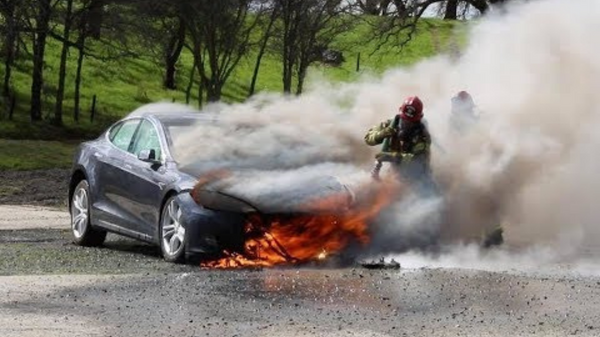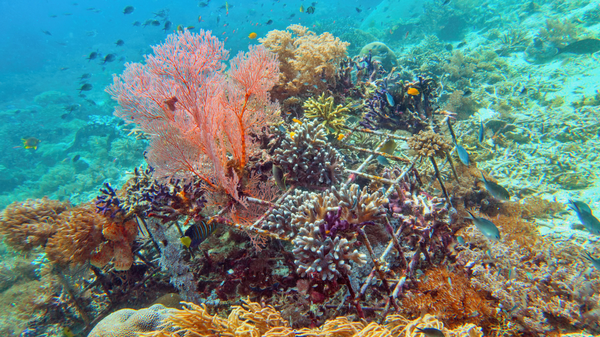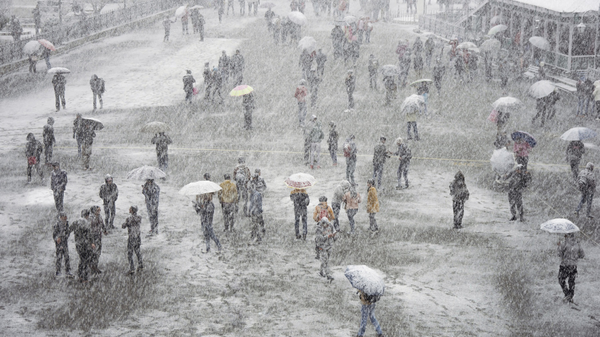YOU SHOULD SUBSCRIBE TO CLIMATE CHANGE WEEKLY.
IN THIS ISSUE:
- Green Technologies Are Dangerous, Not Ready for Prime Time
- Podcast of the Week: The Dark Side of Offshore Wind Power: How It’s Destroying Both Pocketbooks and the Environment (Guest: David Stevenson)
- Corals Show No Sign of Long-Term Decline Amid Warming
- Cold Waves Increasing in India
- Video of the Week: Climate Change Roundtable TODAY at noon CT
- BONUS Video of the Week: Wind Power Fails
- Climate Comedy
- Recommended Sites
Green Technologies Are Dangerous, Not Ready for Prime Time

I have written before about the known dangers green energy technologies pose to human health and life. In last week’s CCW I discussed a potential problem of which I was previously unaware: the micro-plastics/composite waste and chemical leaching of resins from wind turbines as they shred and chip over time.
In a previous CCW I discussed the hazards caused by lithium ion batteries, the motive force of electric vehicles (EVs), modern rechargeable electronics, and the battery farms used to provide electric power in some locations for some uses, usually as a backup to wind and solar power. The batteries overheat, catch fire, or explode far too often. This happens even when the batteries are not in use. It’s never convenient for your car, cell phone, or scooter to catch fire, but it’s even less convenient when something bursts into flames or explodes on a plane or in your garage and burns its surroundings down.
With the recent spate of articles discussing fires caused by EV batteries and atop wind turbines, it seems the mainstream media is only now catching on to what we at The Heartland Institute, the airlines, and actual green technology users have long reported: green tech can be dangerous.
For instance, a recent NBC News story reported on a July 2022 incident in which a transit bus in Connecticut spontaneously burst into flames while parked (I reported on it at the time) and an apartment fire sparked by an electric scooter which killed a five year old girl and a 36 year old woman, among other incidents. Lithium-ion batteries were identified by fire marshals as the cause of more than 200 fires in New York City in 2022 alone, killing six people and injuring nearly 150.
The problem is worse than that. It is not just that the batteries powering EVs randomly burst into flames. An additional problem is that they spew toxic fumes when they do, making them even harder to extinguish, even when fire departments are adequately equipped to do so, which many aren’t.
On this point, the NBC News reporters write,
“The source of the gasses that are creating the flames is confined within a cell battery that will not allow water in,” said Ofodike Ezekoye, a fire scientist and professor of mechanical engineering at the University of Texas at Austin. “When firefighters are responding to these types of incidents, it takes a lot longer to be able to control the fire because it requires so much more water.” …
Hunter Clare and Justin Lopez, who work for the fire department in Peoria, Arizona, have firsthand experience of the hazards.
In April 2019, the two fire captains responded to a call at a facility that was housing thousands of lithium-ion batteries used to store energy for a power grid. The batteries are critical components in such facilities that store solar energy.
Clare and Lopez arrived along with other first responders to find a white cloud of vapor seeping out of the building and drifting across the desert.
“It was staying about 3 to 4 feet off the ground, and it was kind of swaying like sea water,” Clare said.
The firefighters suspected that it was some kind of chemical cocktail. They secured the area and used special devices to test the air, which showed dangerous levels of hydrogen cyanide and carbon monoxide.
Then they waited until the vapors stopped flowing out of the building and the levels of flammable gas dropped. Nearly two hours passed before the firefighters made their way to the front door of the facility. When they opened it, a large cloud escaped the building. Before they could retreat to safety, the space ignited, setting off a powerful explosion.
Coming to a location near you: dangerous fires allowed to burn for more than two hours, belching toxic gases and producing secondary explosions. Hope your local fire departments are prepared.
When EV batteries aren’t burning down homes, businesses, and apartment blocks or making people sick, wind turbines are exploding, collapsing, and burning, threating the lives of people hundreds of yards away from the source of a problem.
Whatever could I be talking about, you ask? Just this: wind turbines are self-destructing with ever-greater frequency. When the nacelles and blades aren’t exploding, tossing dangerous chunks of debris hundreds of yards in every direction—a hazard that has been recognized for some time and captured in numerous videos—they are catching fire or, more recently, simply collapsing, as turbine size and power have grown with limited time allotted for testing of structural integrity before deployment. The turbines were most likely tested using computer model simulations, and my readers know how reliable those are.
Some in the media are finally taking notice. IEEE Spectrum recently ran a story titled “Wind Farm Fires Far More Common Than Reported, Study Finds.” The writers reported on a study that found, “Fires in wind turbines are happening ten times more often than they are reported, according to new research from Imperial College London, the University of Edinburgh and SP Technical Research Institute of Sweden.”
As big wind companies Siemens and GE report multiple billions of dollars in losses in their wind energy divisions caused by unexpectedly high replacement and warranty costs, the news website HITC reports giant wind turbines are falling over at increasing rates. The report indicates newer, larger, more powerful but less-tested turbines are collapsing in unanticipated numbers all around the globe.
“The push to create larger and more powerful wind turbines has led to manufacturing challenges across the wind power industry, Bloomberg reports,” HITC notes.
It seems the old adage is true: the bigger they are, the harder (and more frequently) they fall.
It should go without saying, but I’ll say it anyway: large wind turbines exploding, catching fire, or collapsing under their own weight pose serious safety hazards to landowners, employees, passersby, and the general public in the vicinity of these industrial wind projects—which is a growing number of people because of President Joe Biden’s big push to build more wind, faster, everywhere.
Green hydrogen has a dark side as well, although it doesn’t get as much attention as wind facilities and EVs, being a much smaller though growing segment of the green energy marketplace. There has been limited coverage of the fact hydrogen fueling stations and the vehicles transporting hydrogen fuel have been exploding.
Fueling stations in Norway and California have both exploded in recent years. An explosion at a hydrogen fuel plant in Longview, North Carolina damaged homes and vehicles miles from the plant. An explosion in Norway caused air bags to deploy in cars on the nearest roads, sending at least two drivers to the hospital. Hydrogen is a very flammable gas, so it requires special handling and precautions in how it is transported, where it is stored, how vehicles are fueled, and its growing use for transportation.
To be fair, fossil fuel-powered vehicles and fueling stations and refineries can and do explode on occasion. However, many years and billions of dollars have gone into making them as safe as possible. The question now is whether we are spending enough time and money on testing and ensuring the safety of hydrogen fuel cell infrastructure and hydrogen vehicles, as we did for gasoline and diesel vehicles, or even as much as is being spent to force the rapid acceleration of the use of such technologies and vehicles as a means of fighting climate change.
Whether it is ever-bigger wind turbines, hydrogen fuel technologies, or increased use of EVs and battery power plants with provably combustible batteries, we have a moral duty to reduce the risks of premature or expanded and expedited deployment before undertaking a grand, dangerous experiment with the public. Any government should at least be open and honest about the potential dangers before pushing them on an unaware populace, to allow people to make informed choices.
Objective data reveal no evidence climate change is causing a crisis today. That means we have time to get the tech right. Regardless of whether that means better versions of existing so-called green energy technologies or entirely new, currently undiscovered energy sources, there is no pending climate apocalypse to justify the hasty deployment of energy technologies known to be unsafe, often for unexplained reasons.
Let’s not cause real deaths and destruction today to prevent phantom climate risks tomorrow.
Sources: NBC News; HITC; IEEE Spectrum
Podcast of the Week
In this episode of the Environment & Climate News podcast, we dive into the controversial topic of offshore wind power and its potential negative impact on the environment and economy. We explore the violation of the Endangered Species Act through the construction of wind turbines in the critical habitat of the North Atlantic Right Whale, which could threaten its survival, and the potential loss of the domestic seafood supply due to the disruption of the commercial fishing industry.
We also examine the high costs and minimal reduction of carbon dioxide emissions associated with this renewable energy source, raising the question of whether offshore wind power is a sustainable solution for our energy needs.
Subscribe to the Environment & Climate News podcast on Apple Podcasts, iHeart, Spotify or wherever you get your podcasts. And be sure to leave a positive review!
Get your Copy at Amazon TODAY!
Corals Show No Sign of Long-Term Decline Amid Warming

A new study published by the Global Warming Policy Foundation finds official government data show no signs of any long-term trend in declining coral reef health or reduced global coverage of coral reefs.
Consistent records have been kept for Australia’s Great Barrier Reef (GBR) for longer and with more comprehensive coverage than for any other reef on earth notes long-time reef researcher Peter Ridd, Ph.D., former head of the Marine Geophysical Laboratory at James Cook University in Townsville, Australia, in the study. Data from the GBR indicates coral cover there has grown in recent decades and is currently at an all-time high since recordkeeping began.
“Of the 3000 individual reefs of the Great Barrier Reef, none have been lost, and all have excellent coral, although there are large fluctuations in cover from year to year,” writes Ridd.
For coral reefs in other parts of the world, the recordkeeping has been spotty until the last couple of decades. Ridd reports the available evidence …
…. does not support the proposition that there has been a major drop in coral cover. At worst, there might have been a reduction of 7% from 2000-19, but the stated error margin is of similar size to the difference. In addition, natural variability of the data is also around 10%—higher than the difference between 2000 and 2019.
Data for the East Asia Seas coral bioregion, with 30% of the world’s coral reefs, and containing the particularly diverse ‘Coral Triangle’, show no statistically significant net coral loss since records began.
Amid all the media scare stories about coral bleaching, Ridd points out the vast majority of corals that bleach do not die but recover and are more resilient.
“The public is constantly told that reefs are being irreparably damaged by global warming, but bleaching events, about which there is so much doom-mongering, are simply corals’ natural response to changes in the environment,” said Ridd, according to Principia Scientific International. “They are an extraordinarily adaptable lifeform, and bleaching events are almost always followed by rapid recovery.”
Ridd recognizes overfishing and pollution threaten some coral reefs, but far from corals being among the species most vulnerable to climate change, they are in fact one of the most adaptable and least susceptible to warming-induced harm or destruction, Ridd’s analysis indicates.
This is confirmed in the research cited in “Climate at a Glance: Coral Reefs,” which points to three critical facts about coral: coral has existed continuously for the past 40 million years, surviving temperatures and carbon-dioxide levels significantly higher than what is occurring today; coral thrive in warm water, not cold water; and recent warming has allowed coral to expand their range poleward while still thriving near the equator.
Sources: Global Warming Policy Foundation; Climate at a Glance: Coral Reefs
Cold Waves Increasing in India

A recent study suggests anomalous “cold wave events” have increased by 160 percent over the past decade in India.
Indian Institute of Tropical Meteorology (IITM) scientists Raju Mandal and Susmitha Joseph studied the number of cold wave events over the past seven decades, from 1951 to 2022. Indian meteorologists define a cold wave as the temperature reaching 10℃ (50℉) or lower, or when the location is 4.5℃ below its historic average. The researchers discovered more cold wave days are occurring in India in recent decades than in previous ones.
“In the recent decade, more cold wave days have been observed across the central and eastern parts of the core cold wave zone in India,” Mandal told the India Times.
The increase in cold waves is not uniform across the country, the India Times reports:
According to the research, central and eastern India has seen the average number of cold waves increase by more than five days per decade, and by over 15 days per decade in some places. On average, these regions used to record 2-to-5 cold wave days per 10 years during most decades from 1951-2011, but this rose to nearly 5-15 days in the last decade (ending 2021).
The scientists found cold waves were on the increase even in heavily developed areas where the urban heat island effect tends to register hotter temperatures. In some places—such as Haryana, Chandigarh, and Delhi—the data show cold wave days “increased to 5-10 per decade during the last 20-year period vs. the average of 2-5 in the previous decades.”
“We wanted to understand through the study if there can be a reduction in cold wave events amidst a global warming scenario,” Mandal told India Times. “We, however, found that occurrences of cold wave events have continued even under the general warming scenarios.”
Source: India Times
Heartland’s Must-read Climate Sites
Ecoterrorism? Railroads vs. Pipelines
While a recent devastating train derailment in Ohio does not appear to be ecoterrorism, it does remind us how easily an environmental disaster can happen, and have happened in the past due to accidents or ecoterrorism. Oil, natural gas, and various petrochemical products are transported by rail, trucks, and pipelines, but although pipelines have the lowest accident rate of them, environmentalists fight their construction.
We’ll discuss the failures of the current administration to address the Ohio train derailment, ecoterrorism, and ask why safer means are so often dismissed by supposed environmentalists.
On this week’s episode of Climate change Roundtable, Host Anthony Watts is joined by H. Sterling Burnett and Linnea Lueken to dive into the folly of wind energy. Tune in to Climate Change Roundtable live every Friday at 1PM EST 12pm CST.
Tune in to Climate Change Roundtable live every Friday at 1PM EST 12pm CST.
Wind Power Fails
Wind is among the most popular renewable energy sources, but the truth is, wind power really blows. From collapsing or burning turbines, to snapped lines, to plastics pollution and the need to burn fossil fuels to keep turbines running, Wind Power is failing on every front except government funded subsidies.
It was recently discovered that in Scotland, several windfarms were connected to diesel generators to keep turbine blades spinning during cold weather to prevent bearings from freezing up. The irony is thick, and there are even more examples that we will cover.
On last week’s episode of Climate change Roundtable – broadcast LIVE at noon CT on Friday, Feb. 10 – Host Anthony Watts is joined by H. Sterling Burnett and Linnea Lueken to dive into the folly of wind energy.
Tune in to Climate Change Roundtable live every Friday at 1PM EST 12pm CST.
Climate Comedy































[…] Link: https://heartlanddailynews.com/2023/02/climate-change-weekly-462-green-technologies-are-dangerous-no… […]
[…] Link: https://heartlanddailynews.com/2023/02/climate-change-weekly-462-green-technologies-are-dangerous-no… […]